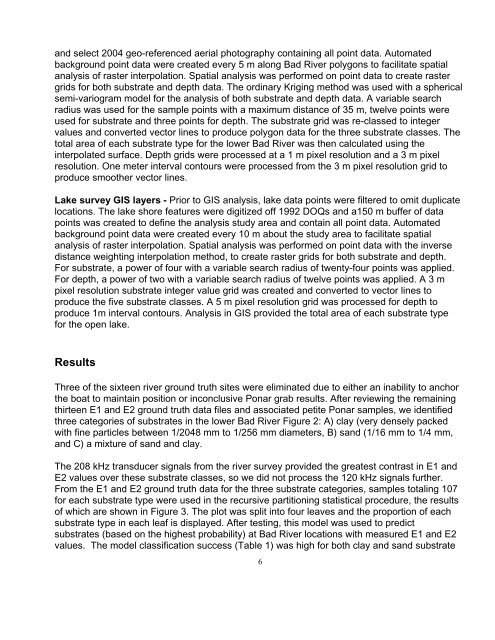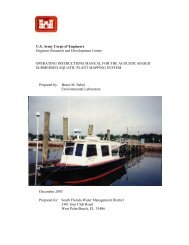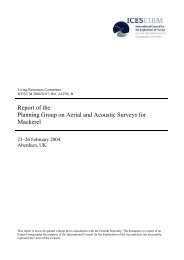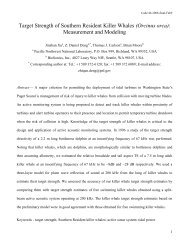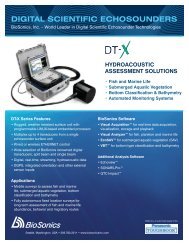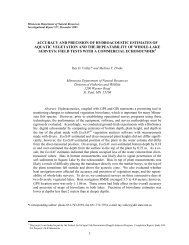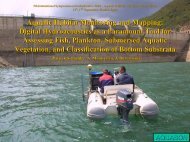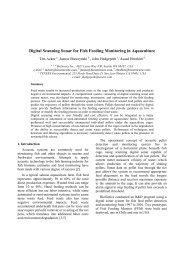Mapping Potential Lake Sturgeon Habitat in the ... - BioSonics, Inc
Mapping Potential Lake Sturgeon Habitat in the ... - BioSonics, Inc
Mapping Potential Lake Sturgeon Habitat in the ... - BioSonics, Inc
You also want an ePaper? Increase the reach of your titles
YUMPU automatically turns print PDFs into web optimized ePapers that Google loves.
and select 2004 geo-referenced aerial photography conta<strong>in</strong><strong>in</strong>g all po<strong>in</strong>t data. Automatedbackground po<strong>in</strong>t data were created every 5 m along Bad River polygons to facilitate spatialanalysis of raster <strong>in</strong>terpolation. Spatial analysis was performed on po<strong>in</strong>t data to create rastergrids for both substrate and depth data. The ord<strong>in</strong>ary Krig<strong>in</strong>g method was used with a sphericalsemi-variogram model for <strong>the</strong> analysis of both substrate and depth data. A variable searchradius was used for <strong>the</strong> sample po<strong>in</strong>ts with a maximum distance of 35 m, twelve po<strong>in</strong>ts wereused for substrate and three po<strong>in</strong>ts for depth. The substrate grid was re-classed to <strong>in</strong>tegervalues and converted vector l<strong>in</strong>es to produce polygon data for <strong>the</strong> three substrate classes. Thetotal area of each substrate type for <strong>the</strong> lower Bad River was <strong>the</strong>n calculated us<strong>in</strong>g <strong>the</strong><strong>in</strong>terpolated surface. Depth grids were processed at a 1 m pixel resolution and a 3 m pixelresolution. One meter <strong>in</strong>terval contours were processed from <strong>the</strong> 3 m pixel resolution grid toproduce smoo<strong>the</strong>r vector l<strong>in</strong>es.<strong>Lake</strong> survey GIS layers - Prior to GIS analysis, lake data po<strong>in</strong>ts were filtered to omit duplicatelocations. The lake shore features were digitized off 1992 DOQs and a150 m buffer of datapo<strong>in</strong>ts was created to def<strong>in</strong>e <strong>the</strong> analysis study area and conta<strong>in</strong> all po<strong>in</strong>t data. Automatedbackground po<strong>in</strong>t data were created every 10 m about <strong>the</strong> study area to facilitate spatialanalysis of raster <strong>in</strong>terpolation. Spatial analysis was performed on po<strong>in</strong>t data with <strong>the</strong> <strong>in</strong>versedistance weight<strong>in</strong>g <strong>in</strong>terpolation method, to create raster grids for both substrate and depth.For substrate, a power of four with a variable search radius of twenty-four po<strong>in</strong>ts was applied.For depth, a power of two with a variable search radius of twelve po<strong>in</strong>ts was applied. A 3 mpixel resolution substrate <strong>in</strong>teger value grid was created and converted to vector l<strong>in</strong>es toproduce <strong>the</strong> five substrate classes. A 5 m pixel resolution grid was processed for depth toproduce 1m <strong>in</strong>terval contours. Analysis <strong>in</strong> GIS provided <strong>the</strong> total area of each substrate typefor <strong>the</strong> open lake.ResultsThree of <strong>the</strong> sixteen river ground truth sites were elim<strong>in</strong>ated due to ei<strong>the</strong>r an <strong>in</strong>ability to anchor<strong>the</strong> boat to ma<strong>in</strong>ta<strong>in</strong> position or <strong>in</strong>conclusive Ponar grab results. After review<strong>in</strong>g <strong>the</strong> rema<strong>in</strong><strong>in</strong>gthirteen E1 and E2 ground truth data files and associated petite Ponar samples, we identifiedthree categories of substrates <strong>in</strong> <strong>the</strong> lower Bad River Figure 2: A) clay (very densely packedwith f<strong>in</strong>e particles between 1/2048 mm to 1/256 mm diameters, B) sand (1/16 mm to 1/4 mm,and C) a mixture of sand and clay.The 208 kHz transducer signals from <strong>the</strong> river survey provided <strong>the</strong> greatest contrast <strong>in</strong> E1 andE2 values over <strong>the</strong>se substrate classes, so we did not process <strong>the</strong> 120 kHz signals fur<strong>the</strong>r.From <strong>the</strong> E1 and E2 ground truth data for <strong>the</strong> three substrate categories, samples total<strong>in</strong>g 107for each substrate type were used <strong>in</strong> <strong>the</strong> recursive partition<strong>in</strong>g statistical procedure, <strong>the</strong> resultsof which are shown <strong>in</strong> Figure 3. The plot was split <strong>in</strong>to four leaves and <strong>the</strong> proportion of eachsubstrate type <strong>in</strong> each leaf is displayed. After test<strong>in</strong>g, this model was used to predictsubstrates (based on <strong>the</strong> highest probability) at Bad River locations with measured E1 and E2values. The model classification success (Table 1) was high for both clay and sand substrate6


